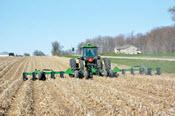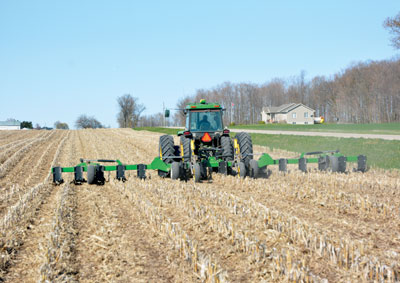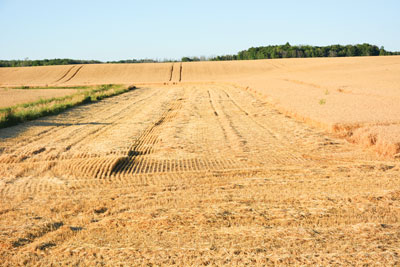
Choosing the Best Management System for Your Operation
By Colleen Halpenny
Historically, fall harvest was never truly considered complete until the moldboard plow had passed through the fields.
These days, best management practices to minimize erosion, retain soil moisture, and ensure maximum organic matter is returned to the soil have created a positive shift toward minimum and no-till applications. However, some producers are still skeptical about leaving lots of residue on the field.
We spoke with industry experts about strategies to manage fall residue as harvest yields continue to be maximized across Ontario.
Know your soil type
The Tillage and Seeding Practices portion of the 2021 Census of Agriculture compiled by Statistics Canada shows that methods are split. Producers in Ontario reported 2,725,046 acres of crops, which saw tillage retaining most crop residue on the surface, while 2,650,063 acres had tillage which incorporated most crop residue into the soil.

Dan Roberts, technical agrologist and vice-president of the Ontario Institute of Agrologists, knows the wealth of individual factors to consider can leave producers unsure of where to start – so he suggests you listen to what your soil is telling you.
“There are definitely growers who are truly no-till operations. But to be successful in that, you need those ideal soils. Not everyone has that. So, exploring what your soil needs, and matching your management to it, is the first step.”
Roberts, based in Norfolk County, knows producers who have nice loam-based soils will need different management styles than those who are heavier clay-based.
“Your style of approach to each individual field should be customized based on its profile, as well as reviewing what crop you’re ending with, and what your plan is for next year. If you have heavy soil, it might be worth exploring a deeper tillage every three to four years to really incorporate that organic matter.
“A light disc after harvest, very shallow at two-to-three inches, will be more than enough for most. You’re just looking to get some exposure, and especially on those heavy soils, to help it warm up in the spring,” he says.
Minimized concentrations
As the applied research coordinator for the Field Crops unit with OMAFRA, Ian McDonald believes that change starts with the combine.
“If residue will be left on the field, you need to ensure that the machine is able to distribute it the same width of the head. Having the best spreader and chaff cutter available is critical to eliminating concentrations of residue that force you into a tillage situation.
“Fall tillage is all about residue management. Producers who are still highly dependent on tillage aren’t managing their system as a whole as best they can,” he says.
McDonald reminds producers that any residue left doesn’t necessarily need to be buried. Instead, he suggests exploring implements that instead cut it up and ensure even distribution across the field.

“We’re slowly changing the idea that you can’t do spring tillage without fall tillage.
“But in reality, a single pass of a vertical tillage tool in the spring will cut up that residue that has protected the field from winter erosion, has now been weakened by the frost and thaw, and you’ve prepped the seedbed with the least tillage possible. And we’re seeing this work across all soil types.”
Adjust slowly and continuously
“The moldboard plow was exceptional at achieving residue management, levelling, weed management, all at once. And now, tillage tools are so specific we really need to understand what you’re looking to achieve in each field,” says Todd Frey, customer service representative with Clean Field Services in Drayton.
For Frey, if any management is needed in the fall, producers should focus on incorporation, and use the multiple modes of adjustment each implement comes with.
“I was told years ago by an older farmer that every tillage tool has adjustments, and you should use all of them in every field. And the only way to check that you’re achieving what you’ve set out to do is to get out of the cab and view the soil. Ensuring you’re seeing the results you need with each pass is critical to not run into a problem in the spring.”
Frey stresses the importance of regular equipment maintenance, to ensure the implement will run evenly across the width of the pass, and to match it to your tractor capacity.
“It is important to look at horsepower requirements when looking at a new piece of equipment. Many of them are designed to operate at a faster speed than traditional tillage tools, so ensuring the tractor and implement are sized to each other is important. There’s nothing worse than doing damage to the field because the tool wasn’t being used as it was intended,” he cautions.
Roberts suggests producers approach changes to their management one practice at a time and review the results.
“If you change everything at the same time, and it doesn’t go well, you don’t know what actually happened. This is a long-term process, and something to review every season.
“Approach each field as a trial and customize your management to its needs, and then manage your expectations and results. This is the soil; it could take decades to complete,” he says.
For McDonald, the goal isn’t about the best yield from the next crop, but instead optimizing for the most profitability from each acre.
“When everyone gathers to share their harvest yields, no one speaks to their soil health. Which is what residue management is trying to achieve. So, you can have a 200-bushel harvest, and poor soil, or a 198-bushel harvest, and soil that next year won’t need extreme supports to keep it profitable.
“I always ask those who are stuck in a tillage mind frame – ‘We don’t plant seeds any deeper than two inches; why are we working or burying residue deeper than that?’
“Changing the mindset of the generational tillage we have been caught in takes a lot of exploring why, what, and how we can manage the soils which we crop. Technology continues to develop tools which are providing better solutions. We need to be taking advantage of them.” BF



Post new comment